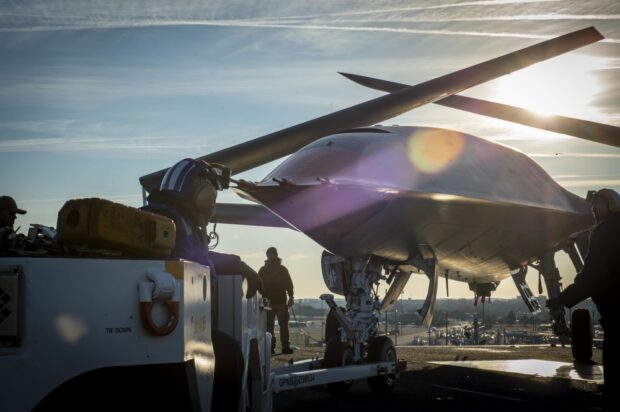Production delays to manufacture Boeing’s MQ-25A Stingray pushed its initial operational capability by a year, the head program executive in charge of Navy unmanned aerial systems announced recently.
The MQ-25A Stingray, the first major unmanned aerial vehicle to deploy on U.S. aircraft carriers, will serve as an aerial refueling tanker on a carrier starting in 2026, Rear Admiral Stephen Tedford, program executive officer, Unmanned Aviation and Strike Weapons said during a presentation at the Navy League Sea Air and Space symposium.
IOC had been set for 2025, with the first deployment slated for 2026 aboard USS Theodore Roosevelt (CVN-71), USNI News previously reported.
The hang-up is developing the production line for the aircraft, Tedford said.
“We are experiencing some production maturity challenges with the MQ-25. People don’t realize how big the actual MQ-25 is,” he said.
“It’s as long as an F-18 with the wingspan of an E-2. It’s not a small UAV.”
MQ-25A builder Boeing in a Monday statement to USNI News said the company has been upfront about the manufacturing delays.
“We have been very transparent with the quality issues faced and notices of escapes in the past associated with coatings applied to metal components. We have owned the challenges that have occurred early in development. Quality escapes combined with the lingering impacts of COVID-19 throughout our teams and supply base have impacted our schedule, but we believe we are turning the corner,” reads the statement.
Boeing won an $805 million contract in 2018 to build the first four Stingrays in a competition that also included General Atomics and Lockheed Martin. In 2020, the Navy exercised an $84.7 million contract to buy three more, with a goal of a fleet of 76 for $1.3 billion.
Boeing’s bid was strengthened by a prototype the company built in 2014 for the abandoned Unmanned Carrier Launched Airborne Surveillance and Strike (UCLASS) program.
The Navy conducted an early round of refueling experiments with the T-1 prototype that wrapped with a series of deck handling tests aboard USS George H.W. Bush (CVN-77) last year.
When the Stingrays get to the carriers in 2026, the Navy will start a battery of tests to integrate the tanker with the rest of the air wing.
USNI News previously reported that the Navy’s notional concept for the aircraft would push the MQ-25A out to 500 nautical miles from the carrier with about 15,000 pounds of fuel to free up the Super Hornet fleet for other missions.
Anywhere from 20 to 30 percent of Super Hornet sorties have been in support of the tanking mission, USNI News has previously reported.
Following the cancellation of the UCLASS program, the Navy crafted a slim list of requirements for the Stingrays.
“The first step is what we call ‘Stingray to the Fleet’,” Tedford told USNI News.
The Navy will field “anywhere from three to five platforms in a permissive environment only providing and taking over the taking roles away from the F-18s so that they can get back to the fight.”
The next phase after basic carrier integration is the “Stingray to the Fight” scheme that will open up more capabilities inherent in the Boeing design, including an internal mission bay. The PEO is also keen on expanding the capability for the aircraft to operate in more difficult environments with limited communications.
“’Stingray to the Fight’ is a non-permissive environment solution set. How are we going to get everything from deck control, launch and recovery with [low probability of intercept/low probability of detection (LPI/LPD)] waveforms? How are we going to control it airborne? How can I also use it as a common network node once it’s on station with other platforms? It has to be operationally adaptive to multiple environments and be able to work with multiple operating systems,” Tedford said.
That will include expanding who can control the aircraft.“MQ-25 needs to have the ability to talk and be managed by any airborne platform, including those of our allies and partners. That’s that open architecture piece that we need to be able to get after… We need the industry’s help, to help us figure out how best to do that and to be able to do it quickly,” Tedford said.
The Navy included $220.4 million for three aircraft in the Fiscal Year 2024 budget, with a planned acquisition of 22 airframes through 2028.
Photo: Sailor repositions a Boeing unmanned MQ-25 aircraft on the flight deck aboard the aircraft carrier USS George H.W. Bush (CVN-77). US Navy Photo
Source: USNI News

